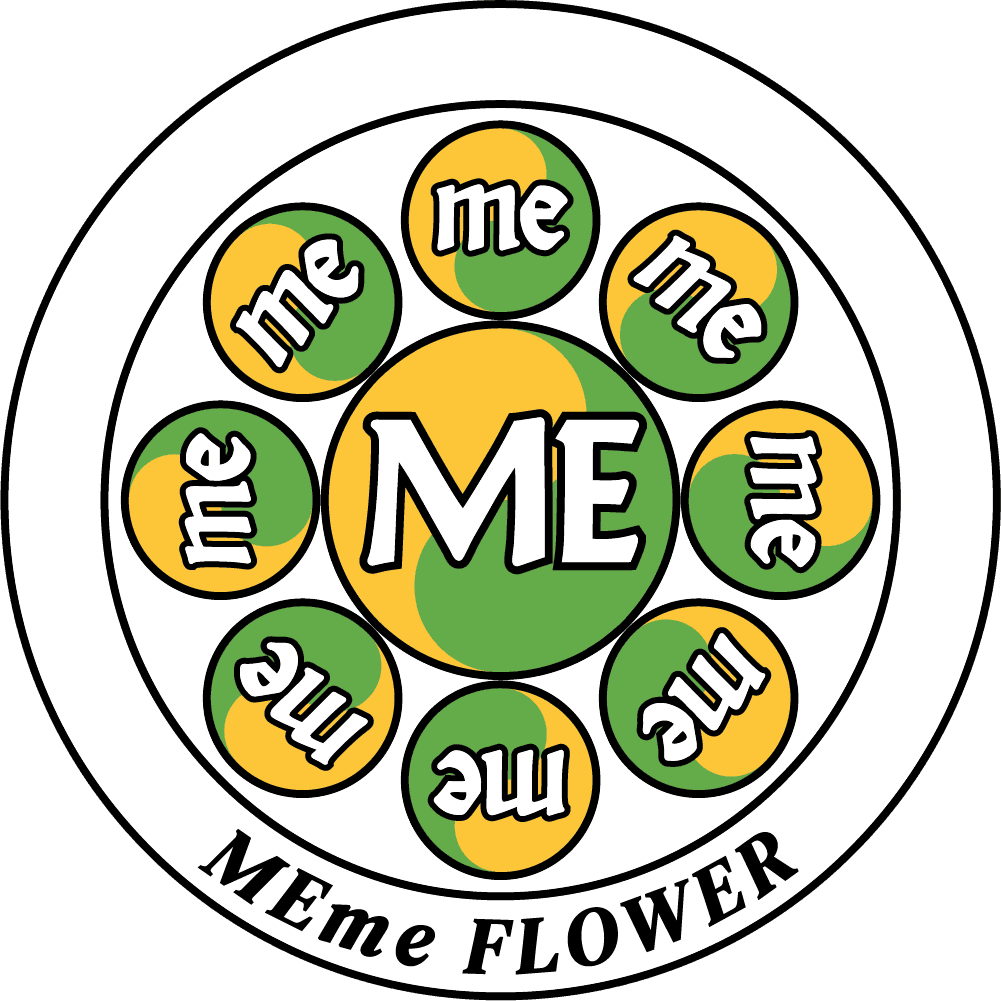The MEme Flower is a central symbol in UTOK, representing the integration of metaphysics (m) and empiricism (e). It illustrates how UTOK unites first-person subjective experience with third-person scientific knowledge, connecting individual perspectives (small "me's") to collective systems of understanding (Big "ME").
Introduction:
The MEme Flower is central to UTOK’s framework and is situated at the heart of the Tree of Life in the UTOK Garden. It plays a critical role in representing how individual perspectives (small "me’s") integrate into collective systems of shared knowledge (Big "ME"). This icon provides a deep and layered symbol that captures the relationship between metaphysics (m) and empiricism (e), both of which are essential in UTOK’s descriptive metaphysical system for understanding reality and our place in it.
1. Metaphysics and Empiricism in UTOK
Metaphysics, in the context of UTOK, refers to the conceptual frameworks we use to map reality—what we understand as "truth" about the fundamental structure of existence. It addresses questions about the nature of being, reality, and the relationship between mind and matter. Many people mistakenly associate metaphysics with speculative or mystical thinking, but UTOK grounds metaphysical thinking in a clear, systematic structure designed to align with empirical knowledge.
Empiricism, by contrast, is about data and information gathered through the senses. It pertains to direct, perceptual experience (first-person empiricism) or systematic observation and measurement (third-person empiricism). UTOK highlights the importance of distinguishing between these forms of empiricism because while science traditionally focuses on third-person empiricism, subjective, first-person experience is equally vital for a holistic understanding of human knowledge and consciousness.
2. Bridging Metaphysics and Empiricism
A core aim of UTOK is to create a bridge between metaphysics and empiricism, addressing the Enlightenment Gap—the disconnect between scientific knowledge and subjective experience. This is where the MEme Flower comes in. It provides a visual metaphor for uniting metaphysical concepts (m) with empirical observations (e), and demonstrates how these two domains can be reconciled into a coherent theory of knowledge.
UTOK’s central mantra, "Marry the Coin to the Tree in the Garden Under God," encapsulates this idea. The Coin (iQuad Coin) represents the individual’s first-person experience, while the Tree of Knowledge represents the empirical, third-person view of reality. The MEme Flower sits at the intersection, illustrating how individual experience and collective knowledge come together in a unified system.
3. The Metaphysical-Empirical Continuum
The MEme Flower operates within UTOK’s Metaphysical-Empirical Continuum. On one end of this continuum is empirical data, ranging from individual anecdotal observations to systematized, scientific measurements. On the other end is metaphysics, where abstract concepts and categories frame our understanding of reality. This continuum allows UTOK to resolve the problem of psychology and to create a unified framework for aligning individual subjective experience with scientific knowledge.
By organizing knowledge along this continuum, UTOK provides clarity on how we experience and understand the world from both a personal and collective perspective. It emphasizes that empirical knowledge (whether first-person or third-person) and metaphysical frameworks are not separate domains, but are in constant interaction, each informing the other.
4. The Big ME and the Small me
One of the most important aspects of the MEme Flower is its fractal-like design, which represents the relationship between individual consciousness (small me) and collective knowledge systems (Big ME). The small "me" signifies an individual's perspective and their first-person, embodied experience of the world, while the Big "ME" represents shared systems of justification, like science or cultural beliefs.
In essence, the small "me" refers to an individual’s personal worldview, or their metaphysical understanding of reality. The Big "ME" represents collective systems of justification that unite individuals into a shared understanding—be it religious, scientific, or cultural. UTOK uses the MEme Flower to symbolize this dialectic, showing how individuals (small me’s) are embedded within and influenced by larger systems of knowledge and belief (Big ME).
5. The MEme Flower and Major Branches of Philosophy
The MEme Flower’s dialectical structure also reflects the major branches of philosophy: metaphysics, epistemology, ethics, aesthetics, and political philosophy. Just as the Flower links metaphysics and empiricism, it also provides a framework for understanding how these different branches of philosophy interconnect. The Metaphysical-Empirical relation forms the foundation, from which ethical questions (what is good?), aesthetic judgments (what is beautiful?), and political philosophy (what is just?) emerge.
In this way, the MEme Flower is not just a symbol for reconciling individual and collective knowledge but also for integrating the various domains of philosophy into a unified worldview.
6. Memes, Memeplexes, and the MEme Flower
The concept of memes, introduced by Richard Dawkins, refers to units of cultural transmission, much like genes in biology. UTOK uses this concept to explore how ideas, beliefs, and values spread within cultural systems. Memeplexes are clusters of memes that form coherent systems, much like UTOK’s idea of justification systems.
The MEme Flower, in this sense, represents a memeplex of knowledge and belief systems. It shows how individual "me’s" connect with and contribute to larger systems of cultural evolution and how these systems, in turn, shape individual perspectives. This dynamic interaction between individual beliefs and collective systems is central to UTOK’s vision of how knowledge evolves and spreads.
7. Connection with the iQuad Coin
The relationship between the iQuad Coin and the MEme Flower is key to understanding the dialectic between the subjective self ("I") and the individual as an object in the world ("me"). The iQuad Coin symbolizes the first-person subjective experience, while the small "me" in the MEme Flower represents that individual from a third-person perspective. Together, they help frame the relationship between personal experience and the larger cultural and scientific systems that shape it.
The MEme Flower thus serves as a bridge between the individual (as framed by the iQuad Coin) and the collective knowledge systems that structure our understanding of reality.
8. Bridging Science and the Humanities
At the core of UTOK’s project is the desire to unify the sciences and the humanities, a goal famously articulated by E.O. Wilson in his book Consilience. The MEme Flower, located at the center of the Tree of Life, represents this unification. It visually embodies the idea that both scientific and humanistic knowledge are necessary for a complete understanding of the world, and that these two domains are in constant dialogue with each other.
Whether you approach the MEme Flower from the scientific side (third-person empiricism) or from the humanistic side (first-person subjectivity), its structure invites you to see the world in a more integrated and holistic way.
Conclusion:
The MEme Flower is a rich, multifaceted symbol that sits at the heart of UTOK’s framework. It visually represents the deep connection between individual subjective experience and collective systems of knowledge, as well as the relationship between metaphysics and empiricism. Through this symbol, UTOK provides a clear pathway for uniting scientific knowledge with human experience, bridging the gap between first-person and third-person realities, and aligning our metaphysical frameworks with empirical data. It also helps to unify the major branches of philosophy and serves as a symbol for the larger project of integrating science and the humanities into a coherent worldview.
Links & Resources
Henriques, G. (2022). The Core of UTOK. A Coherent Descriptive Metaphysical System for Science, Subjectivity, and Wise Collective Living. Medium.
Henriques, G. (2024). A Short Book on The Unified Theory of Knowledge. UTOK Press.
Henriques, G. (n.d.). The Periodic Table of Behaviors in Nature. UTOK Framework.





